Chainsaws are powerful, handy tools that always come in handy when you need to cut down a tree or trim a branch. But they can be dangerous if not maintained properly.
Chainsaw chains wear out and create sawdust, which deposits throughout the engine and makes it harder for the air filter to work properly.
This will cause an increase in fuel consumption, as well as decreased power from the engine. In order to avoid this problem, you should clean your chainsaw carburetor every 6 months.
Table of Contents
The Functions of Your Chainsaw’s Carburetor
The carburetor enables your chainsaw to maintain the proper air-to-fuel ratio. This ensures that you do not end up with engine problems like overheating or too little power. The carburetor mixes the right amount of air with gas to ensure that you have an optimal mix.
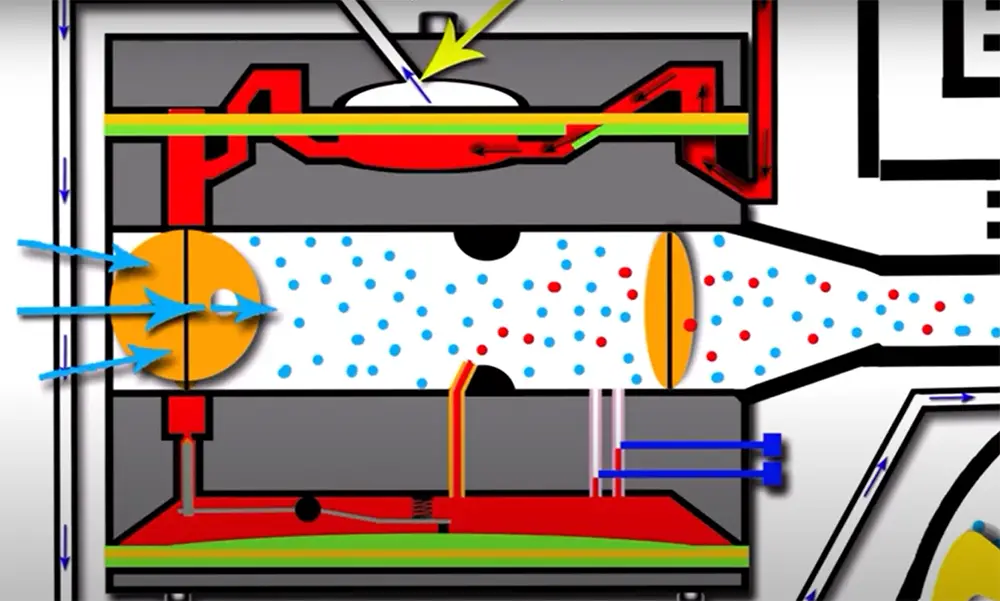
Symptoms of a Bad/Dirty Carburetor:
- Gas and air streams do not mix properly;
- Engine overheats;
- Lack of power output;
- Poor fuel efficiency;
- Engine dies after running for some time (engine gets starved of gas);
- Lackluster performance when cutting wood;
- Smoke comes out of the carburetor (burnt smell) when the chainsaw is running. This indicates that it might be time to clean your saw’s carburetor if you notice any of these symptoms;
Step-by-Step Procedure for Cleaning a Chainsaw Carburetor:
1. Clean the air filter
The air filter is an important part of your saw that must be kept clean. You should check it regularly for dirt or grass clippings and then remove them if necessary.
If you have let the carburetor get dirty, this will involve disassembling the air filter housing to access all parts involved in cleaning (air intake valve, piston chamber). To do so:
- Take off the two screws on top of the cover using a screwdriver. Then carefully pull out the sleeve around your spark plug wire by grabbing onto its base with one hand while pulling upwards slowly but firmly with the other. Take care not to damage any surrounding components when removing this piece – which includes wires running through it! These are easy to damage;
- Remove the air filter cover, then remove the foam air filter element that you will find inside it – use a flathead screwdriver to pry out any pieces of dirt stuck in between the pleats of the filter if necessary. Put some new oil on your finger and rub it onto both sides of this element (in order to prevent dust from accumulating on these surfaces again). Replace with a clean one once done;
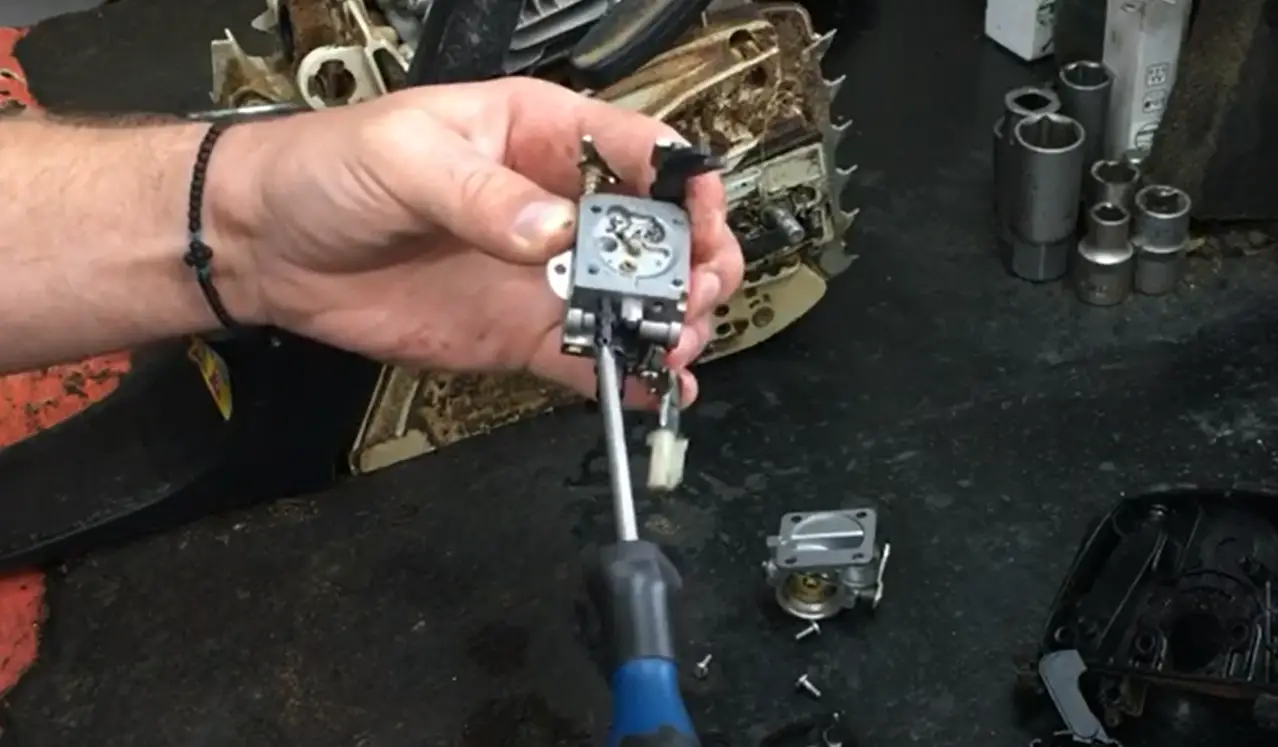
- Clean all other components located around where you have just removed your old/dirty fuel filters by using compressed air or an aerosol canister for cleaning tools. Be careful not to damage anything during this process as well! Take note that most parts are very sensitive so do not apply too much pressure when cleaning;
- Replace all parts you have cleaned back into their original location and ensure that they are properly seated before replacing the cover for your air intake valve housing. Then replace both screws on top of it to secure them in place. Restart your chainsaw afterward, if possible, to confirm whether or not the cleaning process was successful;
2. Clean the carburetor’s intake components
The intake components of your carburetor are located underneath the air filter. They include a butterfly valve and several other valves that help control how much air enters into the combustion chamber (spaces around where fuel is injected):
- Use an aerosol canister for cleaning tools or compressed air to clean these intake components thoroughly. Take care not to damage anything during this process;
- Wipe down all surfaces with high-pressure water/methanol if you do not have any specialized cleaners available. Otherwise, use soap and water, which should be sufficient in most cases. Ensure that no dirt remains on these parts before proceeding further! Make sure they dry completely after doing so as well since moisture will cause corrosion over time;
- Replace all intake components you have cleaned back into their original location;
3. Clean/wash the carburetor’s needle valves:
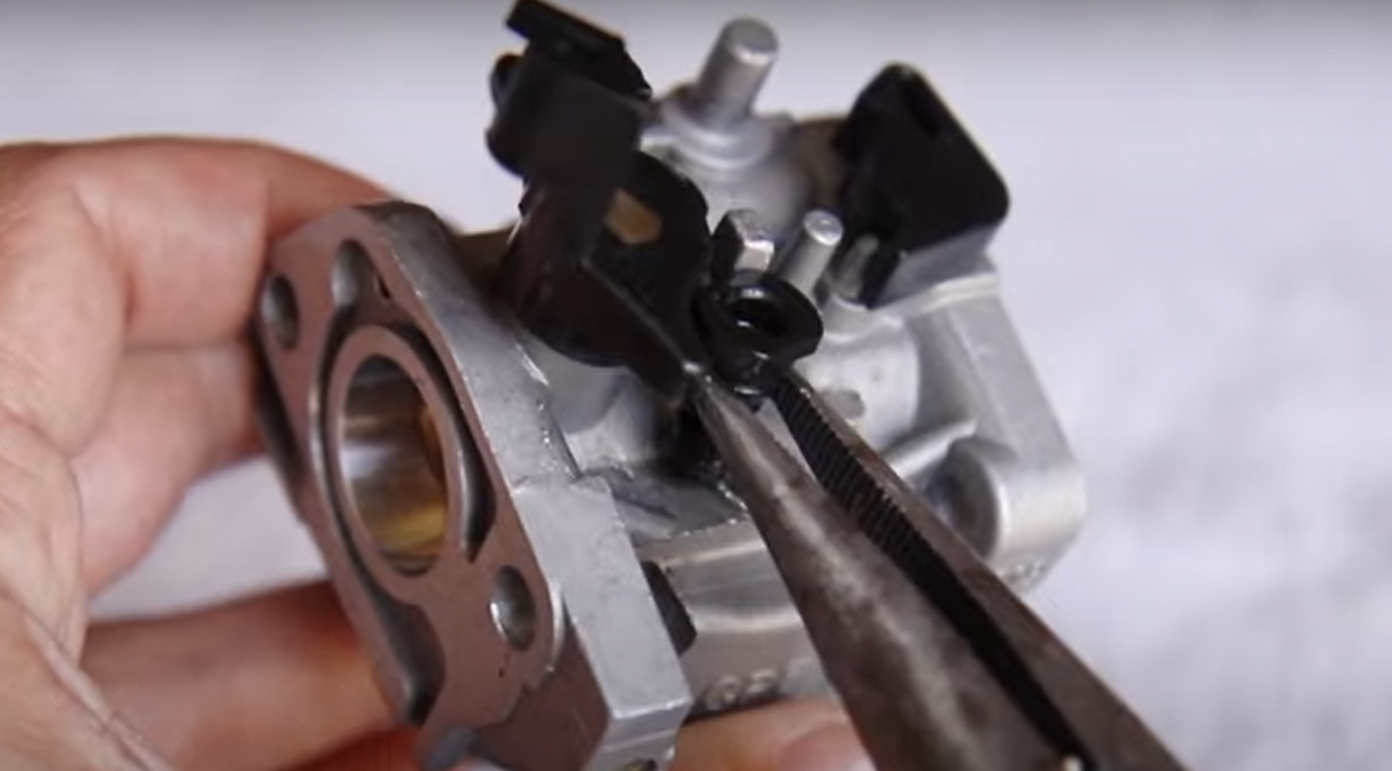
- The needle valves are located underneath the intake components. They each have a cylindrical hole in their center that helps control how much fuel enters into your combustion chamber (spaces around where the air is mixed with gas);
- To clean these parts, you will need to remove them from the carburetor along with any other elements surrounding them – usually by loosening/removing screws holding everything together and then gently prying out the pieces involved when they become loose enough;
- If you cannot access all of these holes easily due to dirt buildup on some surfaces, apply some compressed air or aerosol spray for cleaning tools onto those areas so as to loosen up whatever might be blocking it first before proceeding further. This should allow you to access these holes in most cases;
- Clean all components you have removed using compressed air, a canister for cleaning tools, or aerosol spray – depending on what you have available to use at the time! Take care not to damage anything during this process;
- Keep track of which order each needle valve is installed in. So as to avoid placing them back into incorrect locations when reinstalling everything afterward (e.g., putting one with its fuel hole facing downward while another has its fuel hole pointing upwards). Otherwise, your chainsaw will run erratically and be difficult to control afterward since it won’t receive enough gas/air mixture properly due to poor tuning;
4. Clean the pull cord
The pull cord helps you start your chainsaw by pulling on it with a quick motion, which causes everything to begin running properly – including the carburetor since its butterfly valve opens at this time as well:

- Inspect the pull cord for damage and replace it if necessary. Otherwise, just clean off any dirt that might have accumulated on it over time;
- Use a cleaning solution or water with soap to wipe down both sides of the pull cord, taking care not to let too much moisture get near its inner workings since this could cause issues later on when you go to use your chainsaw again;
- Dry everything thoroughly afterward so no rust forms in the future either;
5. Drain the old fuel and add new fuel
Once you have cleaned off the carburetor, it’s time to drain out any old fuel that might still be in its tank:
- Lower your chainsaw down onto a flat surface and place another container at ground level below where its air filter is located (or under whatever side of the engine has fuel coming from it). Make sure this one can hold all of the gas safely while also being easy for you to access afterward since you will need to remove/replace it after draining some gas into it first;
- Turn on your saw then carefully use an adjustable wrench or similar tool (depending on what type of bolts holding everything together are present in your model) to loosen the bolts around the gas cap;
- Once you have removed it, allow any excess pressure from the inside of your chainsaw’s tank to escape slowly before removing its fuel line as well (this is located underneath where the gas cap was sitting previously). Take note that this part has a small plastic nub at one end that fits into a tiny hole on your carburetor – make sure not to lose or damage anything during removal! This will help maintain proper airflow and prevent dirt buildup in the future;
- Use an adjustable wrench again to remove whichever nuts/bolts holding everything together so you can access them afterward if necessary. Then gently lift off whatever piece surrounds the gasoline reservoir within your chainsaw’s engine based on your model type. Try not to spill fuel everywhere while doing so, since you will need some of it for the next step (unless you drained everything previously);
- Then use a clean cloth or towel to wipe off any dirt that might have accumulated around this area over time. Especially if your chainsaw has been stored somewhere – which can sometimes cause rust issues in addition! You should replace anything damaged during cleaning afterward before reassembling all components properly again;
- Use an adjustable wrench once more to loosen whichever nuts/bolts are present holding together whatever piece surrounds the gasoline reservoir within your chainsaw’s engine based on your model type; take care not to drop these parts anywhere when removing them after loosening everything;
- Once you have done this, slowly pour some clean fuel. The recommended mix of two-cycle engine oil and gasoline is usually 50:50. Although it varies by the manufacturer into your chainsaw’s gas tank until it reaches its maximum fill line. Be aware that the correct amount for one gallon will vary based on what type of model you own;
- Once you get to this point, carefully replace whatever piece surrounds the gasoline reservoir within your chainsaw’s engine based on your model type while making sure not to let too much dirt back in through any openings along the way since doing so might damage/malfunction certain parts over time including an air filter;
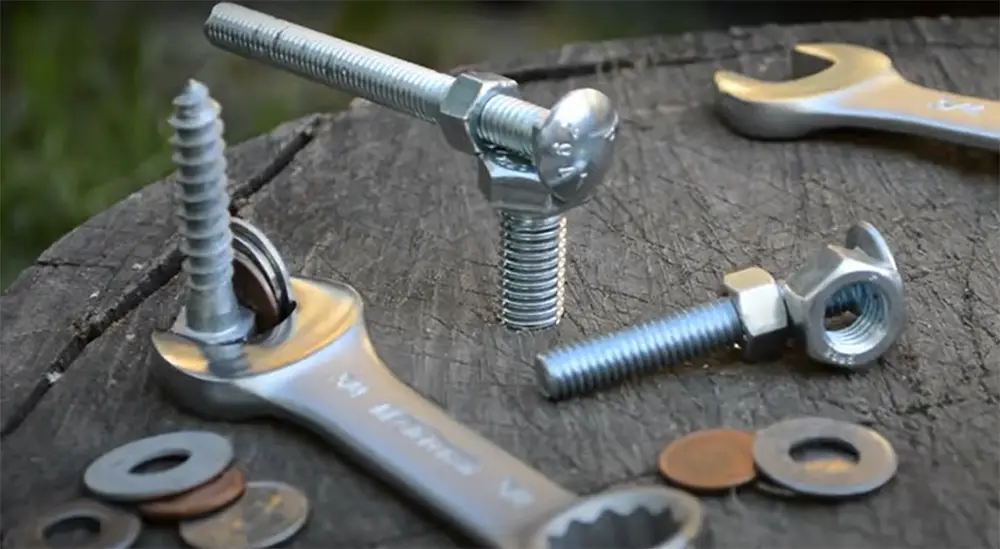
Cleaning a Carburetor Without Opening/Removing It:
Blend the cleaner with gas
To begin, combine some carburetor cleaner with the gas in your chainsaw’s fuel tank. According to experts, 4 ounces of B12 carburetor cleaner [1] should be combined with a tankful of gasoline. Add the carburetor cleaner into the gas tank little by little using a funnel.
Run your chainsaw at an idle or slow speed
After combining the carburetor cleaner with gasoline, start the chainsaw. Allow the chainsaw to run at low RPMs/idle for a few minutes. This allows the liquid to flow through the carburetor, fuel lines, and idle engine.
Clean the pilot air jet
If you want to clean your chainsaw’s carburetor even more thoroughly, add some aerosol B12 to the pilot air jet. The intake mouth is made up of this carburetor component. Because of its sensitivity and the potential hazards, if it is damaged, it is usually hidden from view. The pilot air jet of your chainsaw’s carburetor may be found in your chainsaw’s user manual.
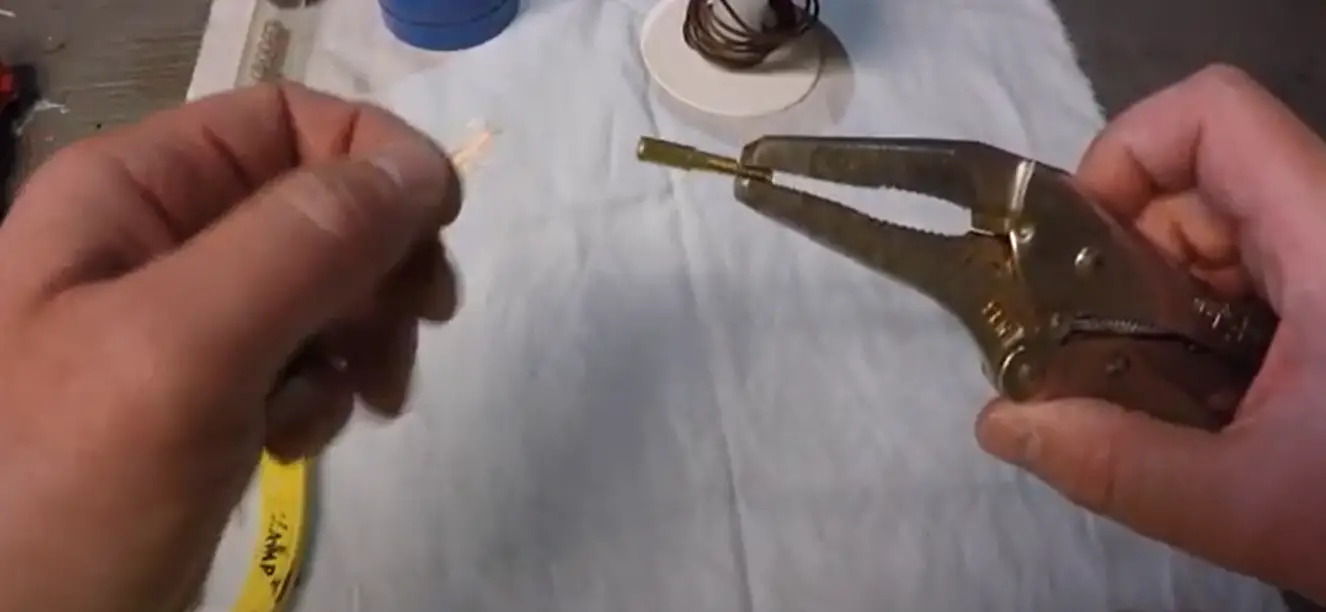
Test your chainsaw
Use the manufacturer’s recommended fuel. Never use gasoline, gas, or large-grade oil in your chainsaw unless specifically approved by the manufacturer and properly maintained. Start your chainsaw and work it at full speed to test it
The Best Carburetor Cleaners
There are many different types of carburetor cleaners on the market. You can get one at a hardware store or elsewhere online. The following are some of the best carburetor cleaners on the market [2]:
- The CRC Carb and Choke Cleaner is VOC-compliant, so it doesn’t damage any catalytic converters or oxygen sensors. It also has a rapid cleaning action;
- The WD/40 Carb/Throttle Body Cleaner is known for its rapid cleaning capability, which involves no dipping or scrubbing and includes an easily replaceable cover;
- The Super Tech Carb Cleaner can effectively remove dirt, grime, and other types of sticky deposits since it has well-rounded cleaning power;
- The Gumout Jet Spray Carb/Choke and Parts Cleaner features a quick-acting formula that prevents the cleaner from escaping when not in use;
You may also ask your chainsaw manufacturer for recommendations on carburetor cleaners since they are generally aware of which chemicals work best on their equipment.
How to Clean a Corroded Carburetor?
Cleaning a rusted chainsaw carburetor, on the other hand, is typically more difficult and time-consuming because it must be disassembled and cleaned:
- Prepare a diluted carburetor cleaner solution with water to clean a rusted carburetor;
- After that, clean the air filter and take it off;
- Wipe the dirt and grime off each component with a brush saturated with the prepared cleaning solution;
- Finally, dry all of the washed items using a clean cloth and put the carburetor back together. Replace it, and your chainsaw is ready to go;
Comparison of Various Indicators for Cleaning a Chainsaw Carburetor
This table compares various indicators for cleaning a chainsaw carburetor. These indicators include the cleaning method, time required for cleaning, cost, and difficulty level.
| Cleaning Method | Time Required | Cost | Difficulty Level |
|---|---|---|---|
| Manual Cleaning | 30 minutes – 1 hour | Low | Easy |
| Ultrasonic Cleaning | 1-2 hours | High | Moderate |
| Chemical Cleaning | 30 minutes – 1 hour | Low-Moderate | Difficult |
| Professional Cleaning | 1-2 hours | High | Expert |
This table compares four different methods for cleaning a chainsaw carburetor: manual cleaning, ultrasonic cleaning, chemical cleaning, and professional cleaning. Manual cleaning is the easiest and cheapest option, but it also takes the most time. Ultrasonic cleaning is more expensive and takes longer, but it can clean the carburetor more thoroughly. Chemical cleaning is a cheaper alternative to ultrasonic cleaning, but it can be difficult to perform correctly. Professional cleaning is the most expensive and difficult option, but it guarantees a thorough cleaning and is recommended for heavily clogged carburetors.
FAQ
Can you clean a chainsaw carburetor without taking it apart?
It is better to disassemble the carburetor in order to clean it thoroughly and prevent future damage from dirt, grime, and corrosion particles.
How do you know if your carburetor is clogged?
The easiest way to know if your carburetor is clogged with dirt and grime is if the chainsaw starts slowing down when you rev it up. If that’s the case, then there are probably some particles stuck in its intake system.
Can you spray carb cleaner on a chainsaw?
An automotive carb cleaner is not meant for spraying directly on a chainsaw. If you are using aerosol carburetor cleaners, place the can at least 12 inches away from your chainsaw while working it to ensure that there’s no misfire or accidental spray of carb cleaner.
What is the best thing to clean a carburetor with?
The best thing to clean a carburetor with is aerosol B12. Not only will it dissolve the gummy residue, but it won’t damage any of its sensitive parts in the process.
Can you use WD40 to clean the carburetor?
The WD-40 carb cleaner is a fast-acting solvent solution that uses a solvent formula to remove stubborn carbon deposits from your carburetor. Any unpainted metal components may be cleaned with WD-40’s combination of cleaners [3].
Can vinegar be used to clean a chainsaw carburetor?
It’s crucial to use a non-corrosive cleanser that doesn’t harm or deteriorate any plastic or rubber parts on the carburetor. Because of the acetic acid in vinegar, metal becomes susceptible to rusting, so it is better not to use vinegar to clean a chainsaw carburetor[4].
Can Sea Foam be used to clean a chainsaw carburetor?
You may clean your chainsaw carburetor effectively with Sea Foam Spray [5]. Sea Foam Spray is solvent with petroleum. It also adds lubricity to various components of the carburetor. For chain saw carburetors, it is a great cleaning agent [6].
Can you pour gas into the chainsaw carburetor?
If straight gasoline is used, the piston and crankcase of a chainsaw will be damaged and destroyed in a matter of minutes. Because straight gas does not take long to burn out such delicate components. Immediately drain the tank into a separate fuel container [7].
How to clean a pole saw carburetor?
Cleaning a pole saw carburetor is a fairly straightforward process.
The first step is to remove the air filter, then unscrew the carburetor from the engine. Once you have the carburetor removed, use a screwdriver to loosen and remove all of the screws that hold it together. With the screws removed, you can carefully take apart each component of the carburetor and clean each one separately. Use a small brush to get rid of any dirt or debris that may have accumulated on them. Make sure to pay special attention to any jets or passages in the carburetor as these will need to be particularly clean for optimal performance.
Once all components are thoroughly cleaned, reassemble the carburetor and reinstall it back onto your engine. It’s important to make sure that all screws are tightened securely so that no air leaks occur during operation. After you have everything put back together, start up your engine and check for proper operation.
How to clean a gas pole saw carburetor?
Cleaning the carburetor on a gas pole saw is not difficult but it is an important part of maintaining your saw. The first step is to disconnect the spark plug wire and remove the air filter cover. Then, use a small brush to clean any debris from the air filter and carburetor. Next, use a can of carburetor cleaner to spray into the carburetor. This will help loosen up any dirt or residue that may have built up in the carburetor. Finally, use a rag to wipe down the carburetor and reassemble everything back together. If you are still having issues with your saw after cleaning the carburetor, it may be time for a new one.
How to clean a hedge trimmer carburetor?
Cleaning a hedge trimmer carburetor is an easy process that can be completed in a few simple steps.
First, you will need to remove the air filter and spark plug from the hedge trimmer. This will give you access to the carburetor. Then, use a brush or compressed air to remove any dirt or debris from the carburetor. Once this is done, use carburetor cleaner and a clean rag to wipe away any remaining residue. Finally, reassemble the parts and test the hedge trimmer to make sure it is working properly.
If these steps do not resolve the issue, then you may need to take your hedge trimmer into a professional for further inspection and repair. This will ensure that your hedge trimmer runs smoothly and efficiently for years to come.
Useful Video: How to Clean a Chainsaw Carb!
References:
- https://www.berrymanproducts.com/products/gasoline/b-12-chemtool-carburetor-fuel-system-and-injector-cleaner/
- https://www.gardentoolexpert.com/how-to-clean-a-chainsaw-carburetor-quickly-a-pro-perspective/
- https://askinglot.com/can-you-use-wd-40-instead-of-carb-cleaner
- https://simplegreen.com/cleaning-tips/rooms/garage/carburetor-small-engine
- https://seafoamworks.com/product/sea-foam-spray-intake-valve-top-engine-cleaner/
- https://www.gardentoolexpert.com/how-to-clean-a-chainsaw-carburetor-quickly-a-pro-perspective
- https://www.hunker.com/12003496/what-happens-if-i-put-raw-gas-in-a-chainsaw

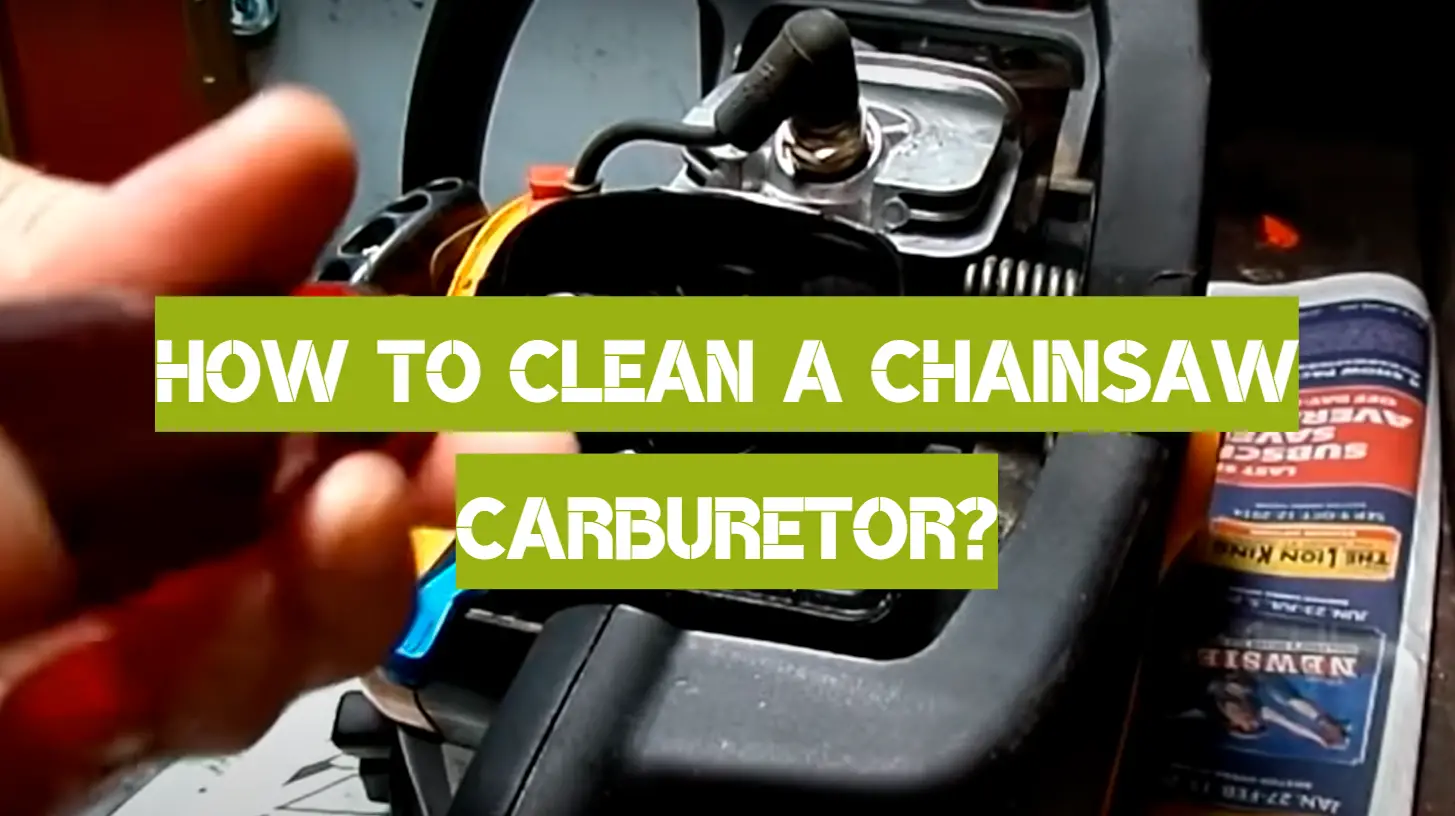





Leave a Reply